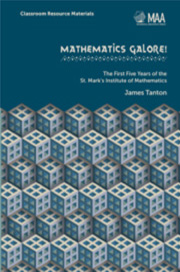Book contents
- Frontmatter
- Contents
- Introduction
- Newsletters and Commentaries
- 1 Arctangents
- 2 Benford's Law
- 3 Braids
- 4 CLIP Theory
- 5 Dots and Dashes
- 6 Factor Trees
- 7 Folding Fractions and Conics
- 8 Folding Patterns and Dragons
- 9 Folding and Pouring
- 10 Fractions
- 11 Integer Triangles
- 12 Lattice Polygons
- 13 Layered Tilings
- 14 The Middle of a Triangle
- 15 Partitions
- 16 Personalized Polynomials
- 17 Playing with Pi
- 18 Pythagoras's Theorem
- 19 On Reflection
- 20 Repunits and Primes
- 21 The Stern-Brocot Tree
- 22 Tessellations
- 23 Theon's Ladder and Squangular Numbers
- 24 Tilings and Theorems
- 25 The Tower of Hanoi
- 26 Weird Multiplication
- Appendices
- Index of Topics
- Classic Theorems Proved
- About the Author
2 - Benford's Law
from Newsletters and Commentaries
- Frontmatter
- Contents
- Introduction
- Newsletters and Commentaries
- 1 Arctangents
- 2 Benford's Law
- 3 Braids
- 4 CLIP Theory
- 5 Dots and Dashes
- 6 Factor Trees
- 7 Folding Fractions and Conics
- 8 Folding Patterns and Dragons
- 9 Folding and Pouring
- 10 Fractions
- 11 Integer Triangles
- 12 Lattice Polygons
- 13 Layered Tilings
- 14 The Middle of a Triangle
- 15 Partitions
- 16 Personalized Polynomials
- 17 Playing with Pi
- 18 Pythagoras's Theorem
- 19 On Reflection
- 20 Repunits and Primes
- 21 The Stern-Brocot Tree
- 22 Tessellations
- 23 Theon's Ladder and Squangular Numbers
- 24 Tilings and Theorems
- 25 The Tower of Hanoi
- 26 Weird Multiplication
- Appendices
- Index of Topics
- Classic Theorems Proved
- About the Author
Summary
PUZZLER
Here is one of my favorite mathematical mysteries.
Consider the powers of two:
1, 2, 4, 8, 16, 32, 64, 128, 256, 512, 1024, 2048, 4096, 8192, 16384,…
Do any of them begin with a 7?
If so, which is the first power of two that does? What is the second, and the third? Are there ten powers of two that begin with a seven? Are there infinitely many?
If, on the other hand, no power oftwo begins with a seven, why not?
ANOTHER PUZZLER
The powers of three begin
1, 3, 9, 27, 81, 243, 729, 2187, 6561, …
Several of them end in 1. Do any powers of three end in 01? In 001? In 0001?
TIDBIT: Benford's Law
In 1881, while looking at books of numerical values in his local library – logarithm tables and books of scientific data, for instance – the American astronomer Simon Newcomb observed that the first few pages of tables seemed to be more worn from use than later pages. He surmised that data values that begin with the digit 1 were looked at more often than values beginning with other digits. He thought that this was curious.
The same phenomenon was later independently noticed in 1938 by the physicist Frank Benford, who went further and examined large collections of data tables from a wide variety of sources: population growth data, financial data, scientific observation, and the like.
- Type
- Chapter
- Information
- Mathematics Galore!The First Five Years of the St. Mark's Institute of Mathematics, pp. 11 - 18Publisher: Mathematical Association of AmericaPrint publication year: 2012



